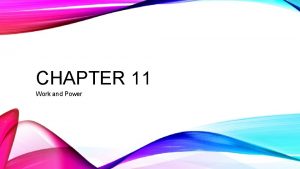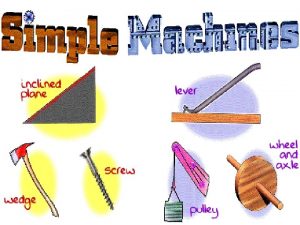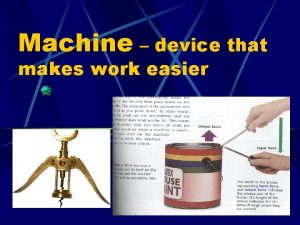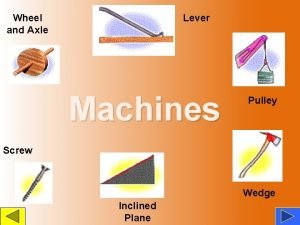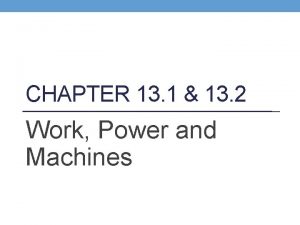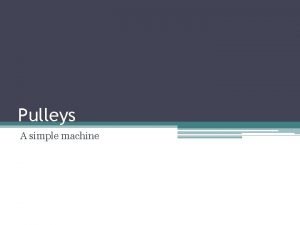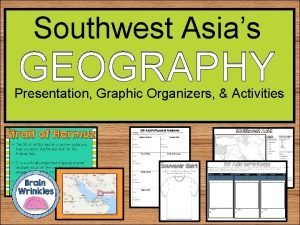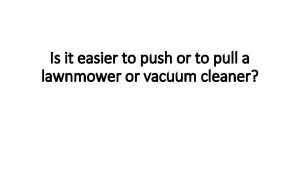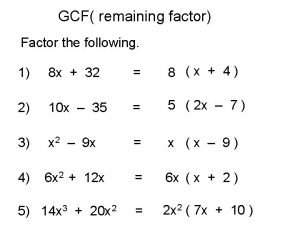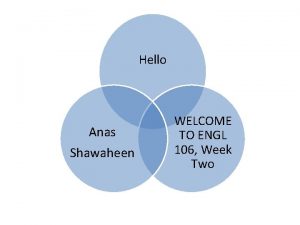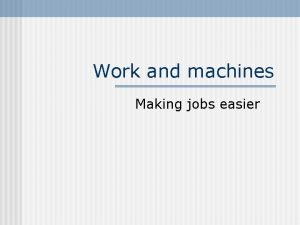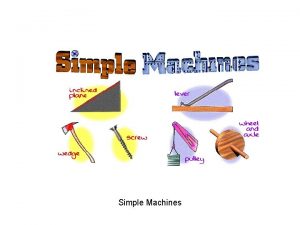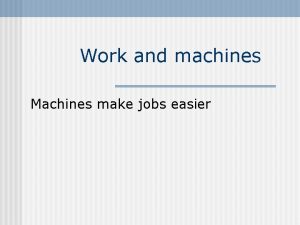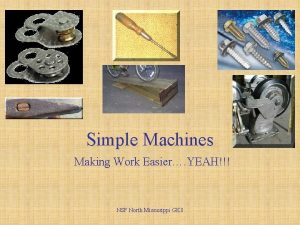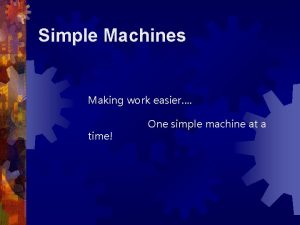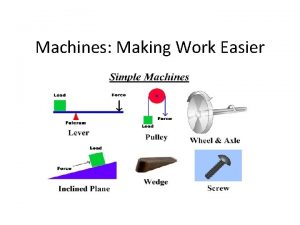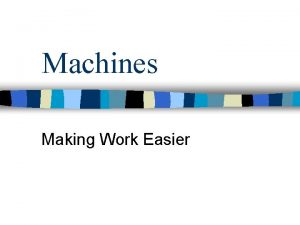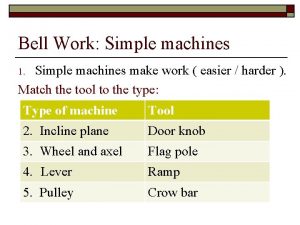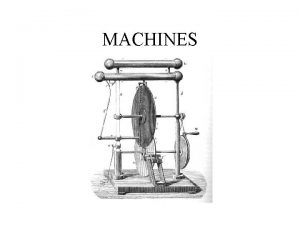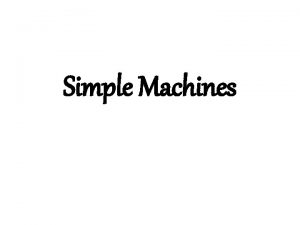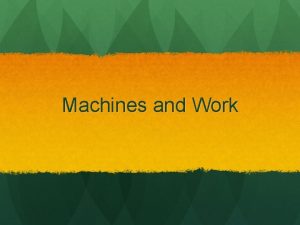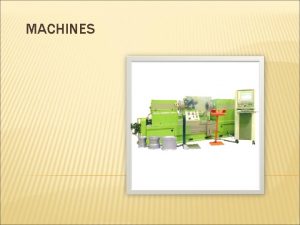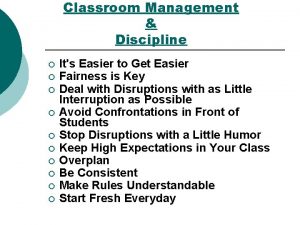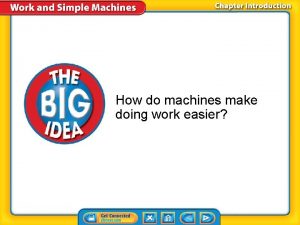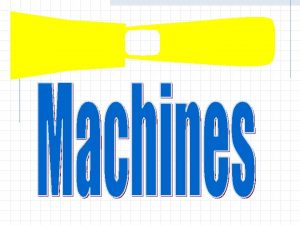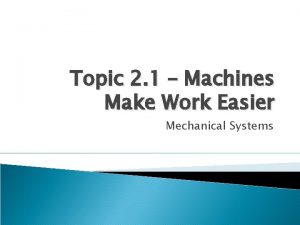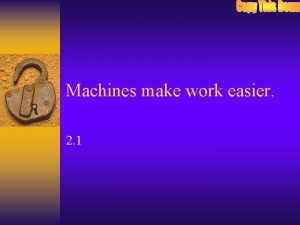Machines Making Work Easier Machines A device that

































- Slides: 33

Machines Making Work Easier

Machines • A device that makes work easier o Some powered by engines/motors, others powered by people • What are some examples?

Machines • Simple Machine = a device that does work with only one movement o 6 types

Advantages of Machines • They make work easier by… 1. Multiplying the effort force 2. Changing the direction of the applied force you exert 3. Increasing the distance through which the resistance force moves 4. Overcoming gravity and friction

Applying Force and Doing Work • Effort Force = the force applied to a machine • Resistance Force = the force applied by the machine to overcome resistance

Review • Where is the effort force? • Where is the resistance force? C B A

Applying Force and Doing Work • W = Fd (Work = Force x distance) • Measured in Joules (J) • You push a box with a force of 200 N. The box moves 1 m. How much work did you do? • W = 200 N x 1 m • W = 200 J

Applying Force and Doing Work • A girl lifts a 12 N weight 1. 5 m. How much work does she do on the weight? • F= • d= • W = Fd

Applying Force and Doing Work • Remember, energy is always conserved so… • You never get more work out than you put in • Win = Wout (in an ideal machine) • Why will work out always be smaller?

The Simple Machines

Levers • A bar that is free to pivot, or turn, about a fixed point • Fulcrum = the fixed point of a lever • Effort Arm = the part of the lever on which the effort force is applied • Resistance Arm = the part of the lever that exerts the resistance force

Levers • Teeter-totters, can openers, tennis rackets • Helps you do more work with the strength you already have

3 Types of Levers • First Class = fulcrum is between the effort and resistance forces (teetertotter) o Multiplies the effort force and changes its direction o Effort moves farther than Resistance

st 1 Class Lever • When the fulcrum is closer to the effort than to the load: o There is a loss in force o There is a gain in speed and distance

st 1 Class Lever • When the fulcrum is closer to the load than to the effort: o There is a loss in speed and distance o There is a gain in force.

st 1 Class Lever • When the fulcrum is midway between the effort and the load: o There is no change in force, speed, or distance

3 Types of Levers • Second Class = resistance is located between the effort force and the fulcrum (wheelbarrow) o Always multiplies effort force o Effort moves farther than Resistance

3 Types of Levers • Third Class = effort force is located between the resistance force and the fulcrum (fishing pole) o Increases speed (cannot multiply the force) o Resistance moves farther than Effort o Multiplies the distance the effort force travels

How well do you know your levers? A. 1 st class B. 2 nd class C. 3 rd class

Pulleys • A grooved wheel with a rope, chain, or belt running along the groove o Examples: Flagpole, blinds • The two sides of the pulley are the effort arm and resistance arm • What does a pulley do? 1. Changes the direction of the force 2. Makes it easier to lift things to high-rise areas

3 Types of Pulleys • A fixed pulley is attached to something that does not move. • Changes the direction of the effort force. • Disadvantage: to have to apply more effort than the load

3 Types of Pulleys • A movable pulley moves with the load o May be attached to a construction crane • Does multiply the effort force • Cannot change the direction of the effort force

Movable Pulley • Disadvantage: have to pull or push the pulley up or down • Advantage: Less effort to pull the load

3 Types of Pulleys • Block and Tackle Pulley = a movable pulley and a fixed pulley • The effort needed to lift the load is less than half the weight of the load

Block and Tackle Pulley • Advantage: effort is less than half of the load • Disadvantage: travels a very long distance

Wheel and Axle • A lever that rotates in a circle around an axle o Two wheels of different sizes connected – the axle being the smaller wheel o Larger wheel may be a crank handle or faucet handle • Examples: door knob water faucet

Wheel and Axle • A gear is a wheel with teeth along its circumference • Effort is exerted on one gear to cause the other gear to turn

Inclined Plane • A plane is a flat surface • Inclined plane is a plane that is slanted • Example: Ramp • Used to move things from a lower to a higher place or vice versa

Inclined Plane How does the amount of work done with a ramp compare to the amount of work done lifting the object? • Work will be the same • Force to lift would be greater than the force used to push • Distance pushed up the ramp would be farther than the distance lifted • Not less work, but less effort

Screw • An inclined plane wrapped around a cylinder • Multiplies an effort force by acting through a long effort distance • The closer the threads on a screw, the greater the mechanical advantage • The plan actually slides through the wood

Wedge • An inclined plane with one or two sloping sides that moves • The wedge is used to increase force • The material remains in place while the wedge moves through it • A wedge changes the direction of the input force

Wedge • Examples: ax, knife, chisel • The “sharper” the wedge, the greater the mechanical advantage • Can be used to split, cut, or fasten (nail/doorstop)

Compound Machines • A combination of two or more simple machines • Examples: o o Lawn mower Pencil sharpener Ax Bicycle
 How do machines make work easier
How do machines make work easier Effforce
Effforce Making work easier
Making work easier A device that makes doing work easier
A device that makes doing work easier How can a machine make work easier for you
How can a machine make work easier for you Wedge wheel and axle
Wedge wheel and axle 6 types of simple machines
6 types of simple machines How does a wedge make work easier
How does a wedge make work easier Input output storage devices
Input output storage devices Section 4 review physical science
Section 4 review physical science Phân độ lown ngoại tâm thu
Phân độ lown ngoại tâm thu Block av độ 1
Block av độ 1 Thể thơ truyền thống
Thể thơ truyền thống Thơ thất ngôn tứ tuyệt đường luật
Thơ thất ngôn tứ tuyệt đường luật Chiến lược kinh doanh quốc tế của walmart
Chiến lược kinh doanh quốc tế của walmart Tìm vết của mặt phẳng
Tìm vết của mặt phẳng Con hãy đưa tay khi thấy người vấp ngã
Con hãy đưa tay khi thấy người vấp ngã Tôn thất thuyết là ai
Tôn thất thuyết là ai Gây tê cơ vuông thắt lưng
Gây tê cơ vuông thắt lưng Sau thất bại ở hồ điển triệt
Sau thất bại ở hồ điển triệt What uses a pulley
What uses a pulley Gases are easily compressed because of the
Gases are easily compressed because of the Geography of sw asia color by number
Geography of sw asia color by number I can easier teach twenty
I can easier teach twenty An easier way to choose contrasting structures is to pick
An easier way to choose contrasting structures is to pick Why its easier than ever
Why its easier than ever Ciphertext alphabet
Ciphertext alphabet Is it easier to push or pull
Is it easier to push or pull Remaining factor
Remaining factor Credit unions are for-profit organizations. true false
Credit unions are for-profit organizations. true false Why was italy easier to unify than greece
Why was italy easier to unify than greece Why are footprints easier to cast than tire tracks
Why are footprints easier to cast than tire tracks Communication-it's much easier than done
Communication-it's much easier than done The roman world takes shape
The roman world takes shape


